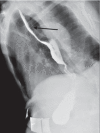Diagnosis and Treatment of Esophageal Candidiasis: Current Updates
- PMID: 31772927
- PMCID: PMC6854261
- DOI: 10.1155/2019/3585136
Diagnosis and Treatment of Esophageal Candidiasis: Current Updates
Abstract
Esophageal candidiasis (EC) is the most common type of infectious esophagitis. In the gastrointestinal tract, the esophagus is the second most susceptible to candida infection, only after the oropharynx. Immunocompromised patients are most at risk, including patients with HIV/AIDS, leukemia, diabetics, and those who are receiving corticosteroids, radiation, and chemotherapy. Another group includes those who used antibiotics frequently and those who have esophageal motility disorder (cardiac achalasia and scleroderma). Patients complained of pain on swallowing, difficulty swallowing, and pain behind the sternum. On physical examination, there is a plaque that often occurs together with oral thrush. Endoscopic examination is the best approach to diagnose this disease by directly observing the white mucosal plaque-like lesions and exudates adherent to the mucosa. These adherent lesions cannot be washed off with water from irrigation. This disease is confirmed histologically by taking the biopsy or brushings of yeast and pseudohyphae invading mucosal cells. The treatment is by systemic antifungal drugs given orally in a defined course. It is important to differentiate esophageal candidiasis from other forms of infectious esophagitis such as cytomegalovirus, herpes simplex virus, gastroesophageal reflux disease, medication-induced esophagitis, radiation-induced esophageal injury, and inflammatory conditions such as eosinophilic esophagitis. Except for a few complications such as necrotizing esophageal candidiasis, fistula, and sepsis, the prognosis of esophageal candidiasis has been good.
Copyright © 2019 Abdimajid Ahmed Mohamed et al.
Conflict of interest statement
The authors declare that they have no conflicts of interest.
Figures


References
-
- Vazquez J. A., Sobel J. D. Candidiasis. In: Dismukes W. E., Pappas P. G., Sobel J. D., editors. Clinical Mycology. New York, NY, USA: Oxford University Press; 2003. pp. 143–187.
Publication types
MeSH terms
Substances
LinkOut - more resources
Full Text Sources
Medical

